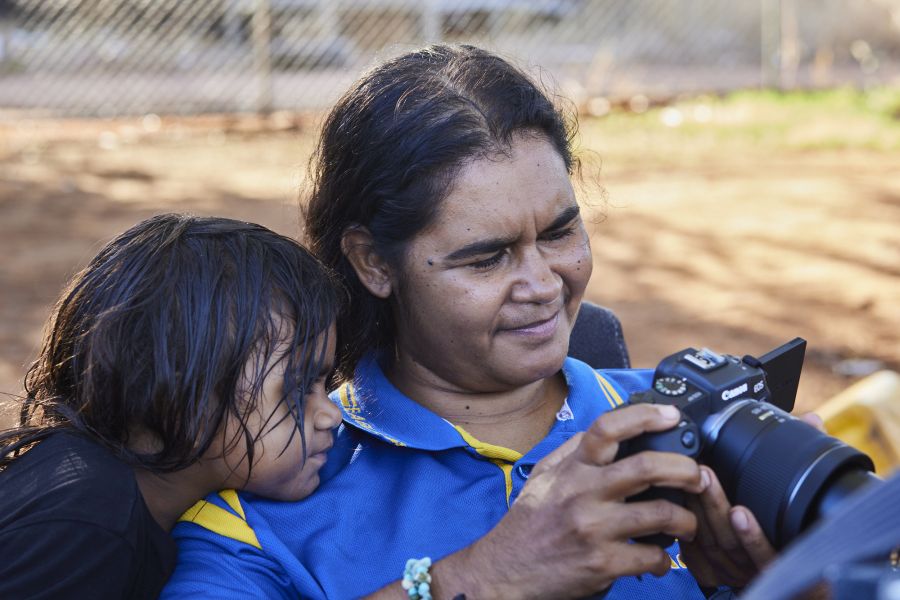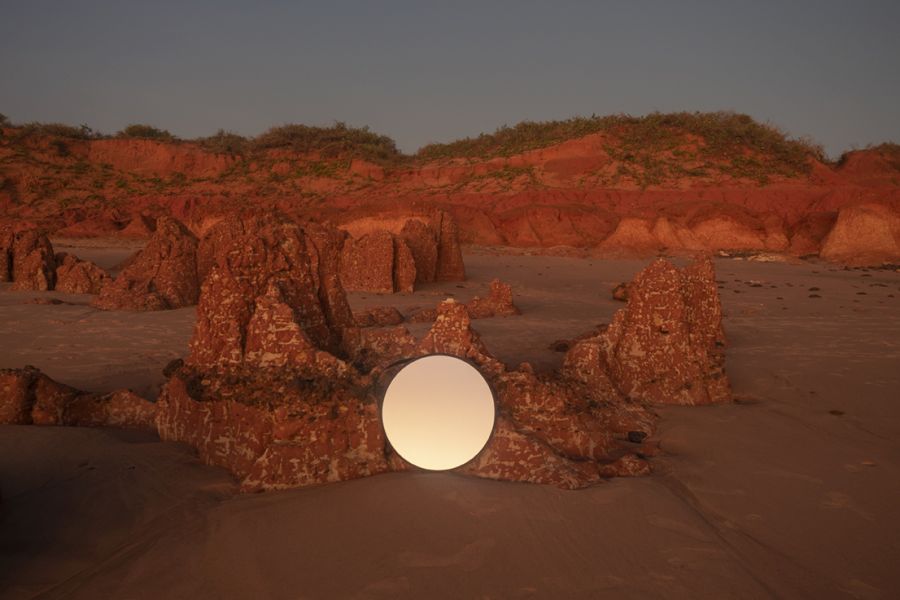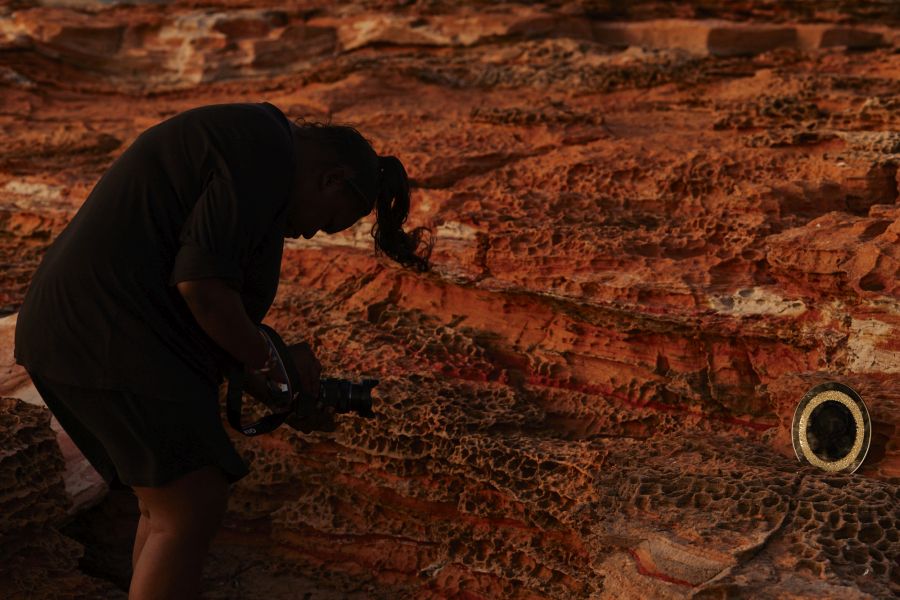Six years ago, curators at the powerhouse photographic arts organisation Perth Centre of Photography (PCP) observed a conspicuous gap within the WA Indigenous arts sector.
After surveying WA Aboriginal Art Centres and their remotely located artists, they saw a distinct lack of access to the digital tools and mediums other city-based artists had long been using. They also noticed an eagerness from many Indigenous artists in remote areas to extend their practice to include photographic techniques.
It wasn’t long before curator Glenn Iseger-Pilkington (then working freelance, but now Curator at Fremantle Arts Centre) and Perth Centre of Photography devised a project to connect more remote Indigenous artists with skills development opportunities in contemporary photography.
A long-term skills model filling a targeted niche
PCP’s new project – named Exposure – began as a week-long intensive in WA’s South West where eight Indigenous artists and arts workers from the Pilbara and Kimberley regions connected with a small group of esteemed photographer-mentors.
During this first skills intensive, emerging photographic artists from Art Centres like Martumili Artists (Newman), Mowanjum Aboriginal Art and Culture Centre (Derby) and Kiro Karo Artists (Kalumburu) were taught DSLR photographic techniques and explored photography as a medium for narrative storytelling.
In 2019, the project expanded with another week-long workshop – Exposure 2.0 – in which many of the original participants returned and several new ones joined to strengthen their photographic skills and develop their ideas into fuller bodies of work. In some cases, the pieces produced were exhibition-worthy and toured with PCP to Rotterdam Photo later that year.
However, perhaps the most significant impacts of Exposure so far have occurred during the project’s latest phase – Exposure 3.0 – in which just four artists have been invited back to work with photographic mentor Sarah Landro – who is Co-Director of WA photographic organisation Camera Story, as well as being PCP’s Special Project Manager.
Landro has worked with this small group of emerging artists over the past 18 months to offer them the kind of deep-roots mentoring that has strengthened their photographic practices and opened new and arguably more powerful ways for them to share their stories.
Expanding artists’ storytelling reach
Nuriah Jadai is a Mangala and Martu woman from the Bidyadanga community in WA’s Kimberley region, who has also spent considerable time with the Parnngurr community in the Pilbara region where she worked with Martumili Artists.
She is one of the four Exposure 3.0 emerging artist participants – alongside Mary-Lou Orliyarli Divilli (Mount Barnett, Gibb River), Maria Fredericks (Kalumburu) and Maria Maraltadj (Kalumburu) – and describes the work she has done with the program as transformational to her practice.
Jadai explains that, until Exposure, her chosen art mediums were painting and drawing. However, she’s now using photography to tell her stories with greater directness and immediacy – a quality she feels is benefiting her practice, as well as her audience’s understanding of her work.
‘Photography takes you right there and you can relate to it very quickly,’ Jadai tells ArtsHub.
‘So, I think that while mediums like painting hold memories and stories that we ourselves [as Indigenous artists] must see and feel, photography is different. Photography captures visual memories, which I think make it more accessible to people outside our family and culture.’
Read: The WA art prize connecting past, present and future
As well as expanding their practices, Exposure 3.0 has allowed its four participants to produce full bodies of photographic work, which will be exhibited at PCP in its upcoming show New Voices in Australian Photography.
Project mentor Sarah Landro believes the works in this show reveal important new layers of Indigenous storytelling.
‘I think this work shows a side of Australia that we don’t get to see,’ she tells ArtsHub.
‘As well as that, it’s proving what’s possible when these artists have sustained access to resources and equipment,’ she continues. ‘That’s why we wanted to design Exposure 3.0 in this way – to allow a smaller number of emerging artists to have greater access to resources and mentoring over a longer period.

‘We wanted to break that cycle of them doing one week’s work with us and then going back to their communities where they couldn’t access those resources.’
Landro describes the experiences of Exposure artist Mary-Lou Orliyarli Divilli to illustrate this point.
‘Mary-Lou lives 300 kilometres away from her Art Centre [Mowanjum Aboriginal Art and Culture Centre]. So, to use one of the Art Centre’s cameras she had to travel a long way. But now she has her own camera and equipment, which is hugely important for her to continue her photographic work.’
Forging international networks between First Nations artists
Evidently, it can be easy for the city-based arts community to forget the particular tyrannies of distance facing artists in remote and regional Australia, and the barriers to access (especially around technology) that accompany that isolation.
Though it’s also true to say that technology can be a vital force in bridging vast geographical divides, and in the context of Exposure 3,0, technology has been used to start bringing Australian First Nations photographers and First Nations photographers from other parts of the world much closer together.
As Landro explains: ’It was important for Exposure 3.0 to facilitate greater cultural exchange between First Nations photographers from different parts of the world, and for our participants to make those kinds of connections.
‘At one point, we arranged for the group to have a Zoom session with Ecuadorian First Nations photographic artist Eli Farinango,’ Landro adds, pointing to an Exposure 3.0 experience that left strong impressions on at least one of its participants.
Jadai explains: ‘When Eli told us her story about how people [from outside her community] would go to her reservation camps and take photos to tell [her community’s] stories, she didn’t want that. She didn’t want that for her people and her community. She wanted to tell her story, her way and how it is.
‘And we have that [in our communities] too,’ Jadai continues. ‘People come to our community and see how it is without really knowing us. So what she said really touched me.
‘And I must say that she also takes beautiful photos. I love her photos. So seeing her style and lighting, and the different tips she gave use when we met her on Zoom, was awesome.
‘I hope one day we can go there and meet her on her Country, and she can come to our Country too,’ she says.

For Landro and PCP, these hopes of further cross-cultural, international dialogues are front of mind as they plan the program’s future.
‘Obviously now we’ve been talking with the artists about what’s next,’ Landro says. ‘And one of the most important things we’re planning for the next phase is about bringing First Nations photographic voices onto a global platform, and putting more remotely-based First Nations stories into an international context,’ she says.
New Voices in Photography opens Friday 10 March, 6pm at Perth Centre of Photography (PCP). The exhibition runs until 13 May.
The Exposure project (phases 1.0, 2.0 and 3.0) has been supported by the Australia Council for the Arts, as well as the Australian Government’s Regional Arts Fund. PCP’s ongoing annual program of exhibitions and projects is supported by The WA Department of Local Government, Sport and Cultural Industries (DLGSC).
Disclosure: this article’s author was involved in the project’s initial funding application (made to the Australian Council in 2017), but has since had no further involvement in the project.





